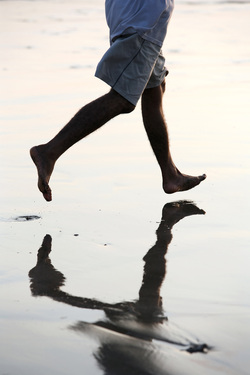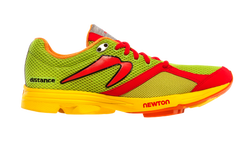
Barefoot running has increased in popularity in recent years. In fact, Dr. Segler recently lectured at a medical conference on the topic of barefoot running trends. Part of the appeal in barefoot running technique is to increase your efficiency by using more natural running biomechanics in order to hone your running form.
The American Podiatric Medical Association has a position statement declaring that barefoot running is an unsafe activity and is not recommended by podiatrists. Of course not all podiatrist agree with this position. I happen to be one of those dissenting physicians.
Toenail fungus is common among runners. In fact all fungal infections are common among runners. Particularly athlete's foot. Athlete's foot is nothing more than a fungus infection of the skin on the foot. A toenail fungus infection is actually caused by the same organism that causes athlete’s foot.
When you run your feet sweat, moisture collects in your shoes and the ideal environment for fungal growth is created. If you run on back-to-back days the problem is compounded because your running shoes never completely dry out.
If you happen to develop a case of athlete's foot, the fungus is growing between the layers of the skin. As the skin peels it sheds fungal spores into your shoes. These spores of course are the seeds from which fungus grows.
If you are running, doing hill repeats or some other strenuous workout, and you repeatedly bumped the toes and the end of of the toenail on the inside of the running shoe, the fungal spores can get between the toenail and the underlying nail bed. The fungal spores begin to grow and develop into a fungal toenail infection.
However when you run barefoot, you not have any risk of bumping the toenails repeatedly against an inside of a running shoe that is ripe with fungus. So in that respect, running barefoot is actually much lower risk for developing a toenail fungus infection as compared to running with running shoes.
The risk is mainly related to the potential for fungal spores to collect in your shoes and then have trauma where those spores are actually in contact with the toenail in such a way that they can become embedded in or underneath the toenail and start to grow. If you are wearing minimalist running shoes such as the Vibram Five Fingers without socks the risk of developing one of these toenail infections actually increases significantly.
If you start to notice discoloration such as white or yellowish spots where the toenail seems to be changing and getting thicker it could be a fungal toenail infection. Treating these infections is not really a big deal. Our podiatrist can actually bring a laser to your home or office in order to directly kill the fungus and help your toenails returned to their normal clear and healthy state. For more information on discount toenail fungus laser treatment and laser toenail fungus removal treatment visit http://www.lasertoenailhouston.com/
Dr. Christopher Segler, DPM is Board Certified, American Board of Podiatric Medicine. He believes the best podiatry practice combines cutting edge technology with the old-school convenience of house calls. He makes podiatry house calls for young active adults who want to get rid of their funky toenails as quickly as possibly. He brings the laser to homes and offices throughout the Houston Metro including Downtown Houston, the Houston Heights and Sugar Land, Texas. If you have a question about fungal toenail laser treatment, you can reach him directly at 713-489-7674.
The American Podiatric Medical Association has a position statement declaring that barefoot running is an unsafe activity and is not recommended by podiatrists. Of course not all podiatrist agree with this position. I happen to be one of those dissenting physicians.
Toenail fungus is common among runners. In fact all fungal infections are common among runners. Particularly athlete's foot. Athlete's foot is nothing more than a fungus infection of the skin on the foot. A toenail fungus infection is actually caused by the same organism that causes athlete’s foot.
When you run your feet sweat, moisture collects in your shoes and the ideal environment for fungal growth is created. If you run on back-to-back days the problem is compounded because your running shoes never completely dry out.
If you happen to develop a case of athlete's foot, the fungus is growing between the layers of the skin. As the skin peels it sheds fungal spores into your shoes. These spores of course are the seeds from which fungus grows.
If you are running, doing hill repeats or some other strenuous workout, and you repeatedly bumped the toes and the end of of the toenail on the inside of the running shoe, the fungal spores can get between the toenail and the underlying nail bed. The fungal spores begin to grow and develop into a fungal toenail infection.
However when you run barefoot, you not have any risk of bumping the toenails repeatedly against an inside of a running shoe that is ripe with fungus. So in that respect, running barefoot is actually much lower risk for developing a toenail fungus infection as compared to running with running shoes.
The risk is mainly related to the potential for fungal spores to collect in your shoes and then have trauma where those spores are actually in contact with the toenail in such a way that they can become embedded in or underneath the toenail and start to grow. If you are wearing minimalist running shoes such as the Vibram Five Fingers without socks the risk of developing one of these toenail infections actually increases significantly.
If you start to notice discoloration such as white or yellowish spots where the toenail seems to be changing and getting thicker it could be a fungal toenail infection. Treating these infections is not really a big deal. Our podiatrist can actually bring a laser to your home or office in order to directly kill the fungus and help your toenails returned to their normal clear and healthy state. For more information on discount toenail fungus laser treatment and laser toenail fungus removal treatment visit http://www.lasertoenailhouston.com/
Dr. Christopher Segler, DPM is Board Certified, American Board of Podiatric Medicine. He believes the best podiatry practice combines cutting edge technology with the old-school convenience of house calls. He makes podiatry house calls for young active adults who want to get rid of their funky toenails as quickly as possibly. He brings the laser to homes and offices throughout the Houston Metro including Downtown Houston, the Houston Heights and Sugar Land, Texas. If you have a question about fungal toenail laser treatment, you can reach him directly at 713-489-7674.



 RSS Feed
RSS Feed